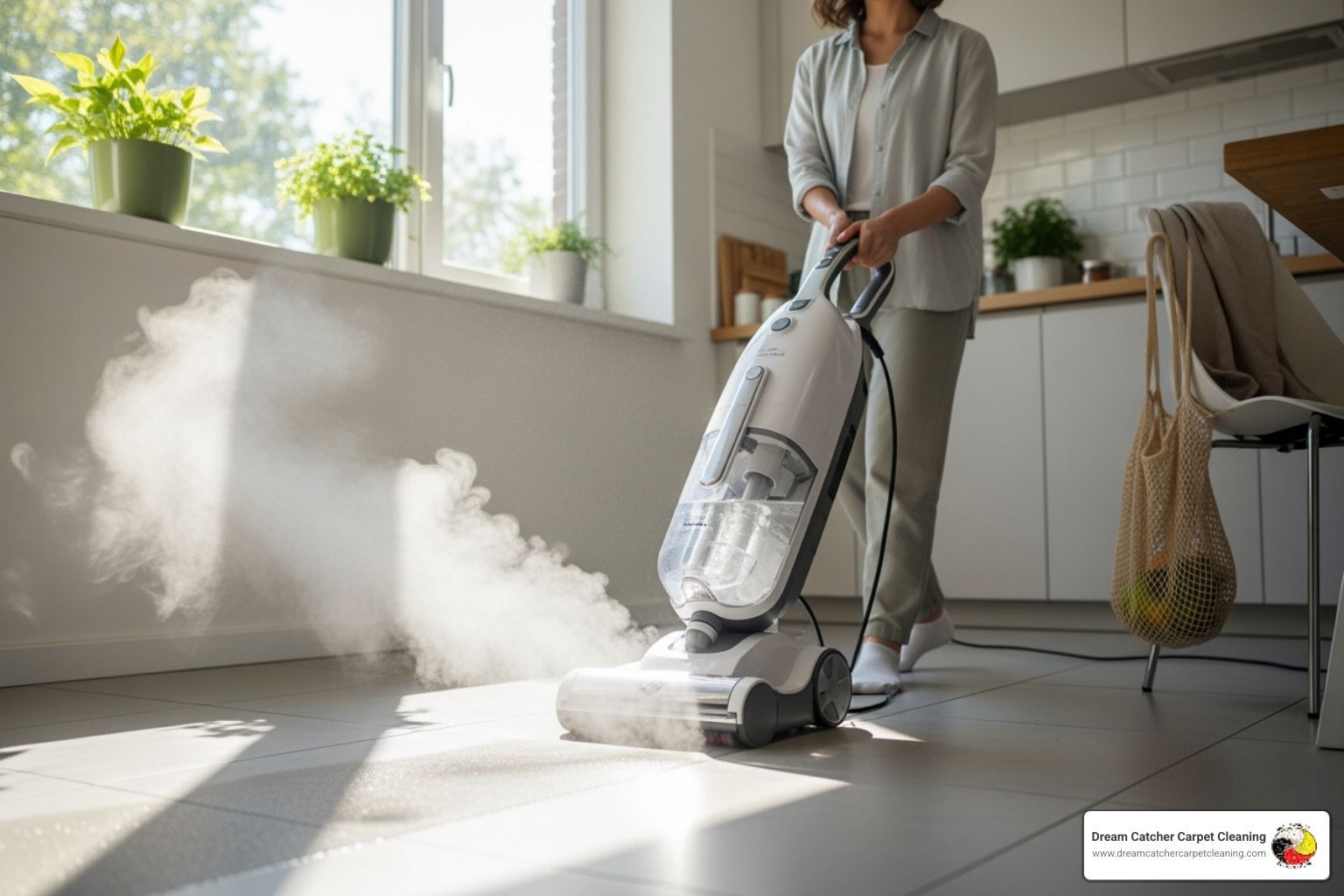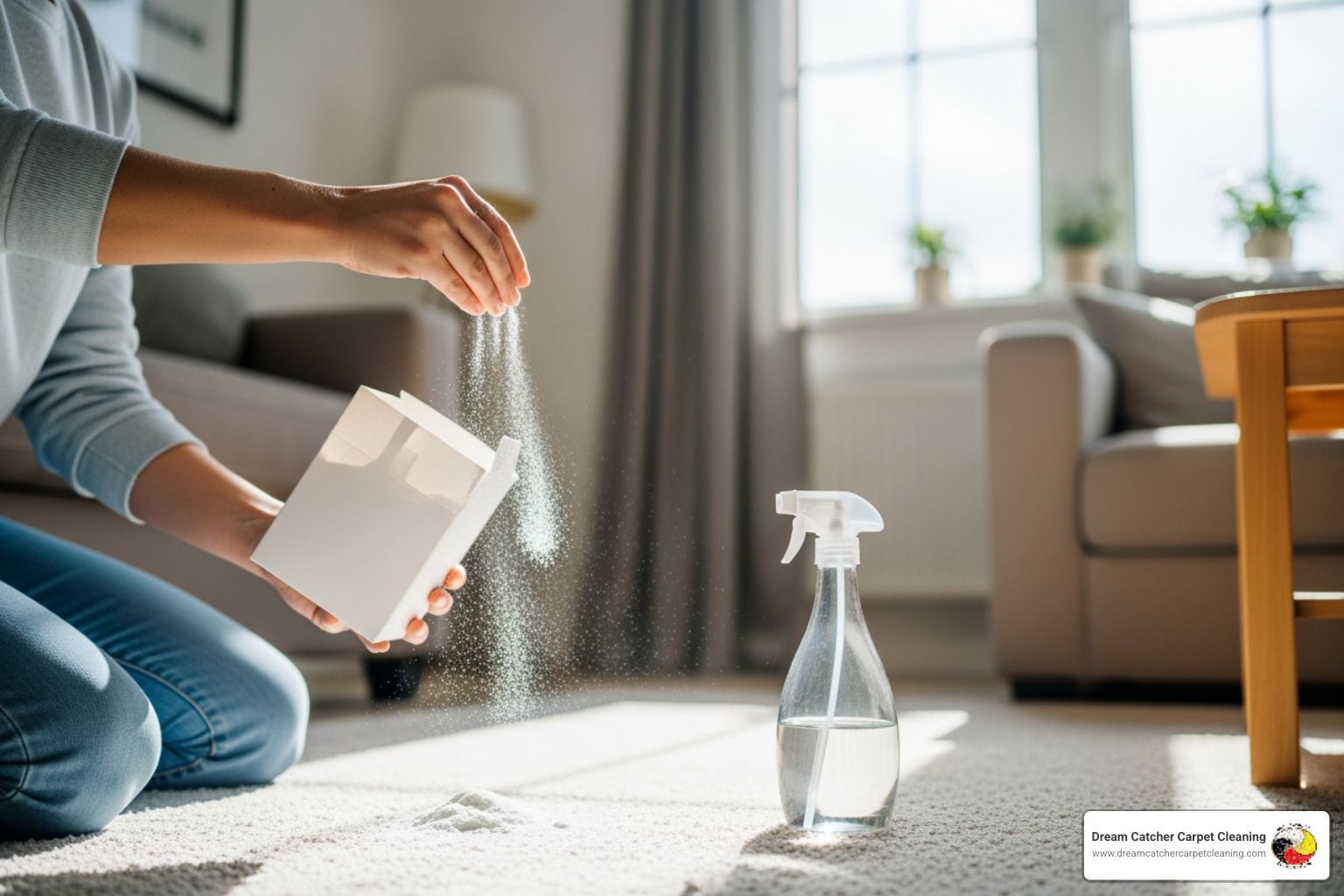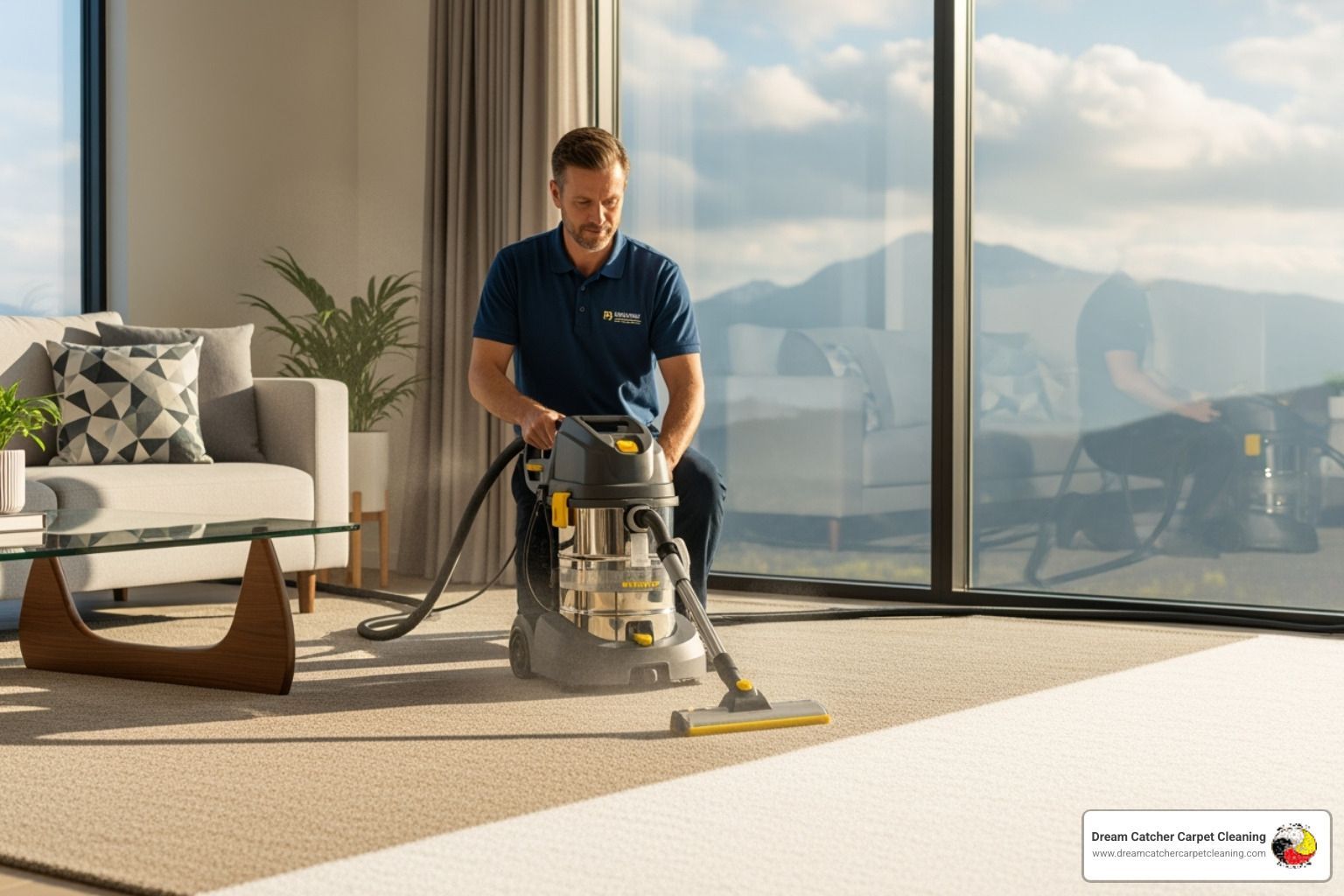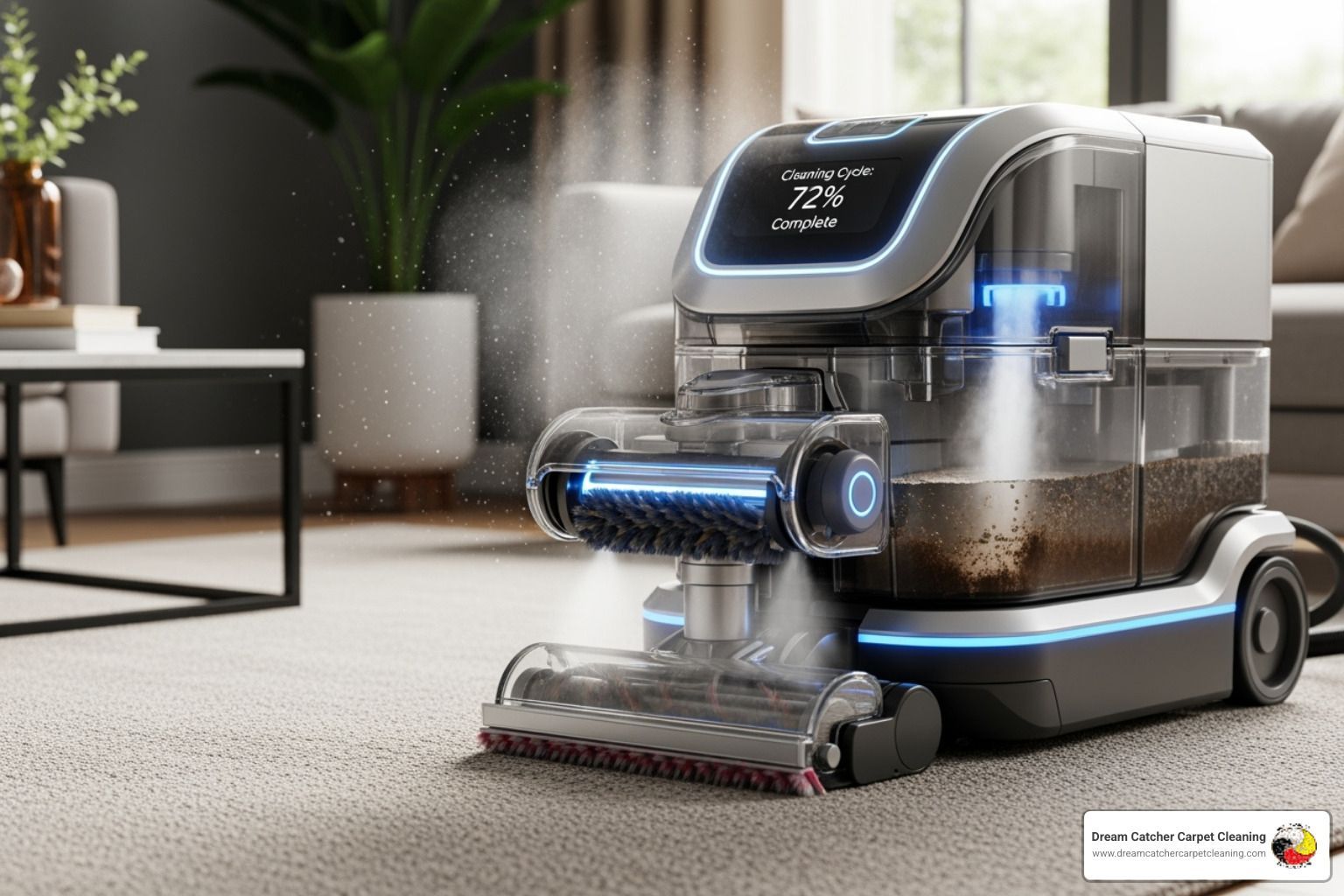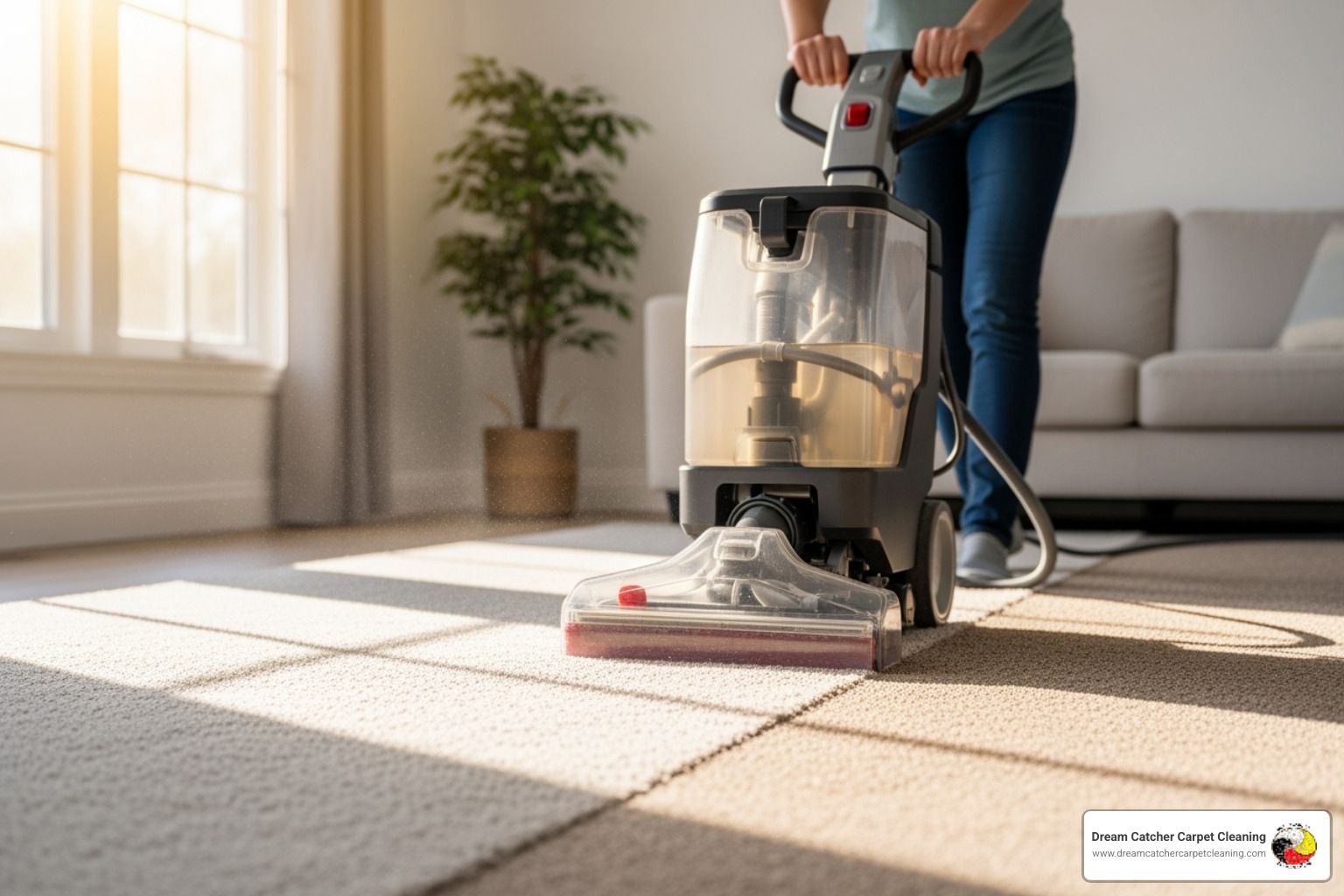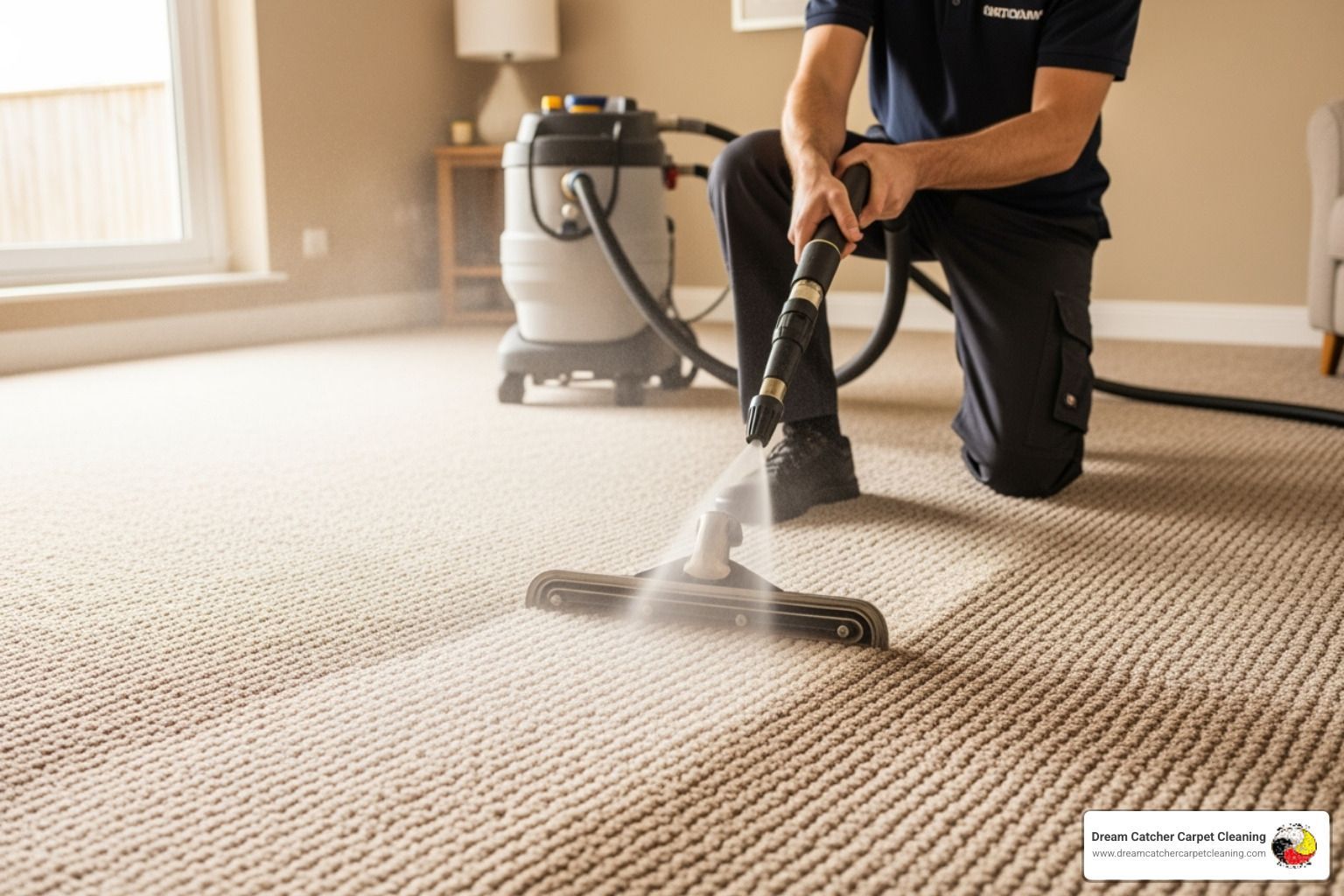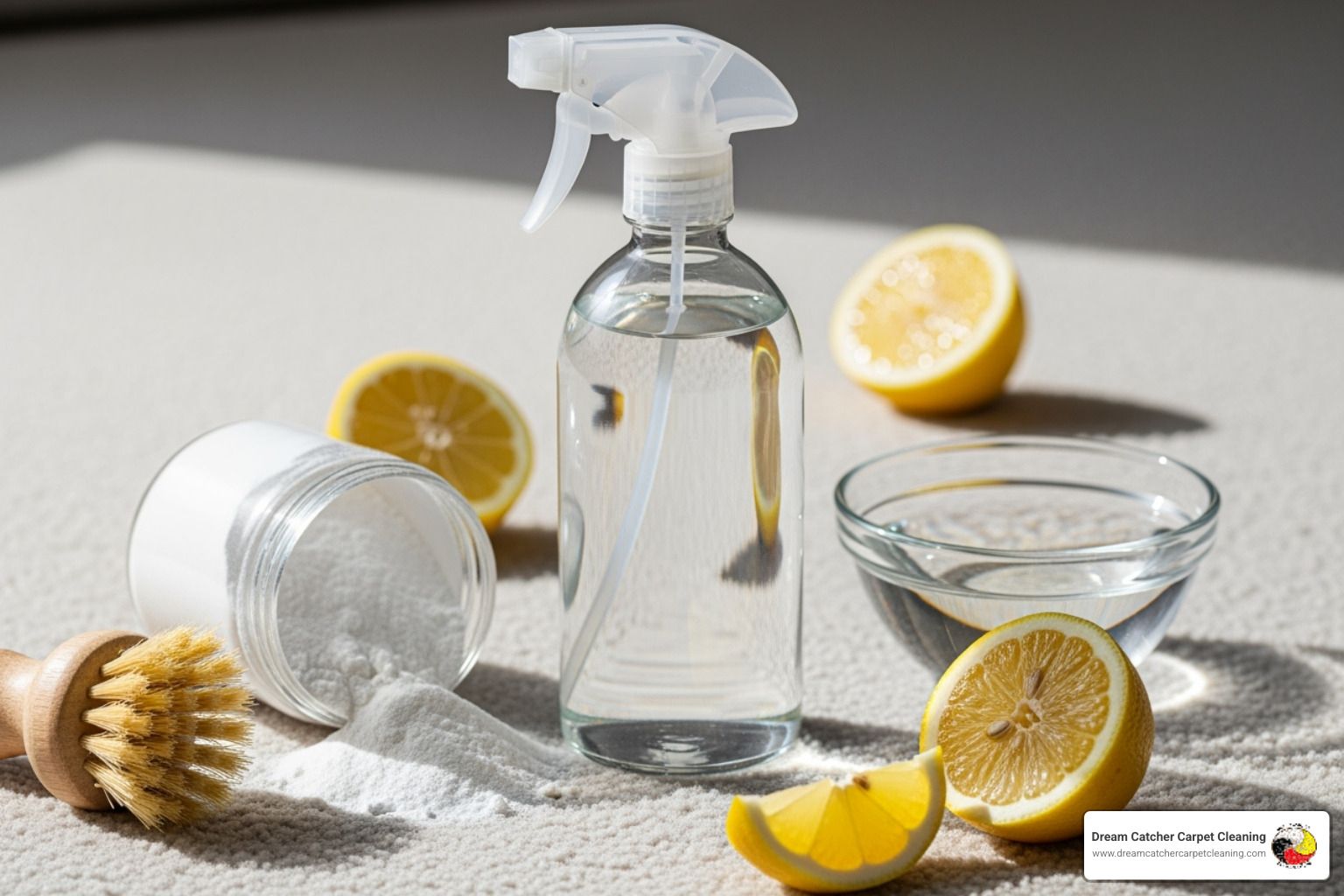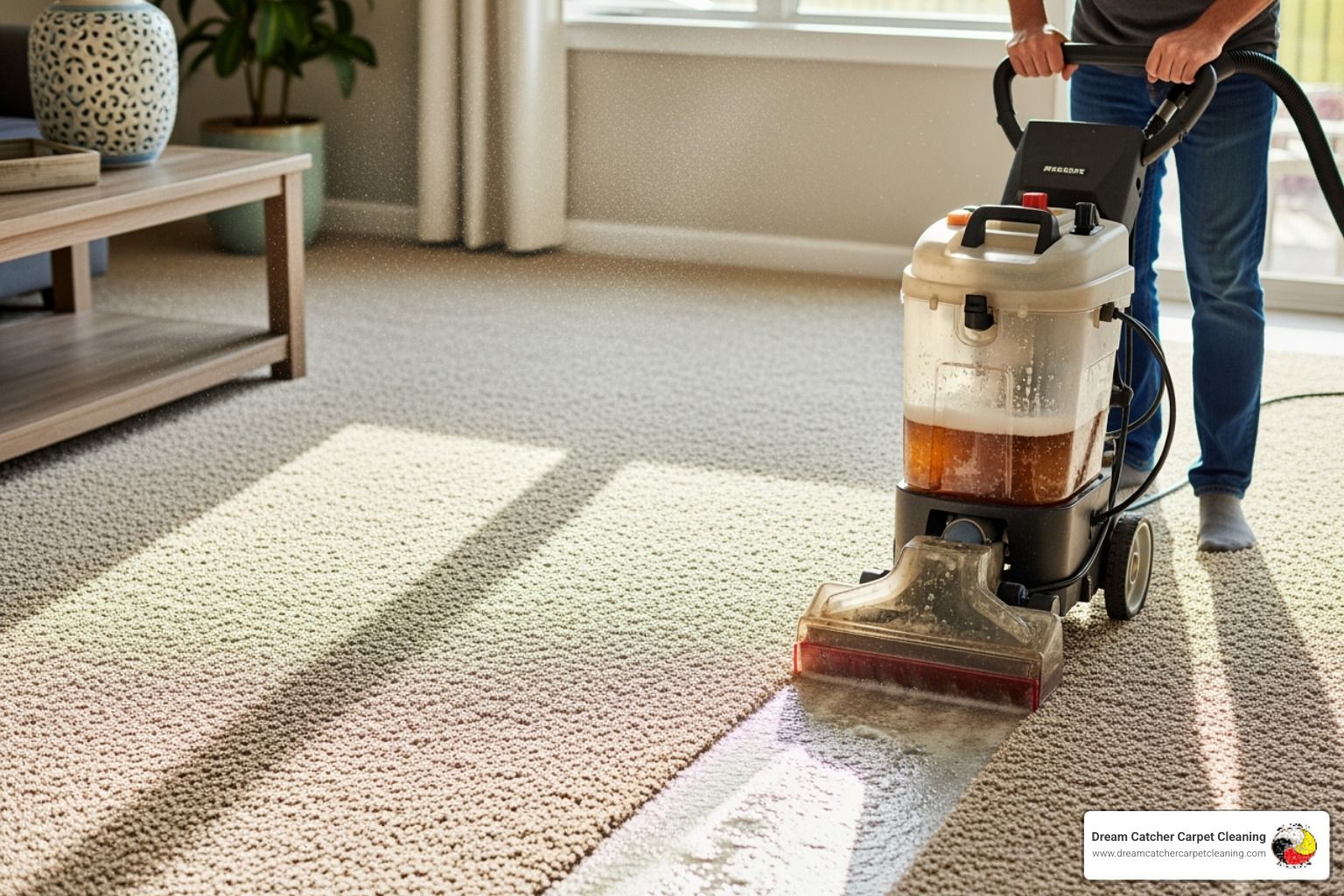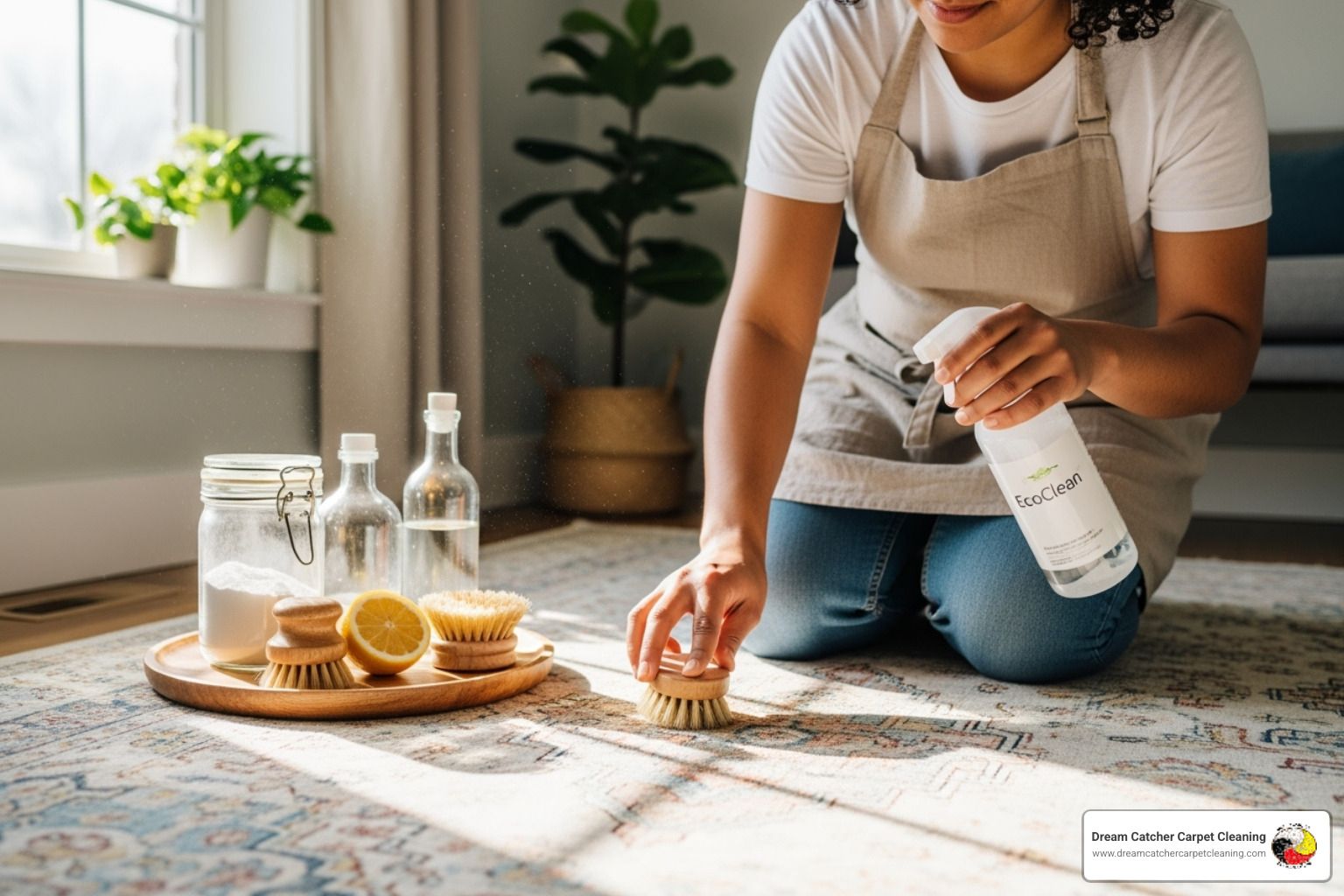Why Finding the Best Solution to Clean Carpets with Pet Stains Matters
The best solution to clean carpets with pet stains depends on whether you're dealing with fresh accidents or set-in odors that have been haunting your home for months. Here's what works:
Quick Answer for Fresh Stains:
- Enzymatic cleaners- Break down proteins in urine, feces, and vomit
- Oxygen-based cleaners- OxiClean Carpet Stain Remover (removes stains in 10 minutes)
- DIY solution- 50/50 white vinegar and water mixture
For Set-In Stains:
- Kids 'N' Pets All-Purpose Stain + Odor Remover(enzymatic)
- Nature's Miracle Carpet Shampoo(removes old stains in one treatment)
- Professional extraction when DIY methods fail
The key difference between regular spills and pet accidents? Pet waste contains proteins that bond permanently to carpet fibers when exposed to heat or harsh chemicals. That's why The Humane Society warns against using steam cleaners on pet urine - the heat actually sets the stain and odor forever.
Why timing matters: Fresh stains respond to simple solutions, while old stains need enzyme treatments that can take days to fully work. The wrong approach can make odors worse and encourage pets to re-mark the same spot.
I'm Clarence Smith, owner of Dream Catcher Carpet Cleaning with over 22 years of IICRC-certified experience tackling Colorado's toughest pet stain challenges. The best solution to clean carpets with pet stains combines the right chemistry with proper technique - and I'm here to share what actually works.
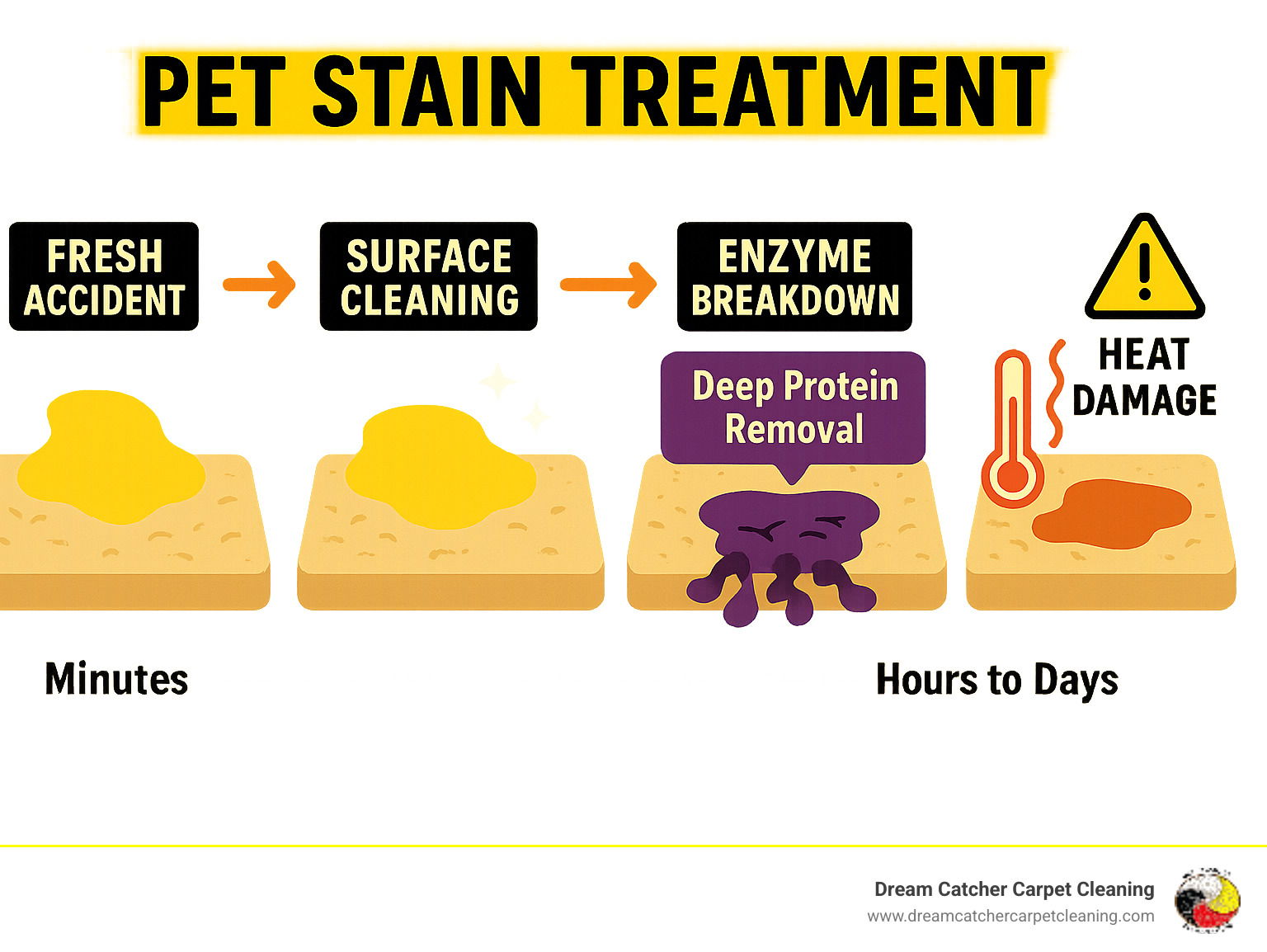
Spot the Stain Before You Clean
Here's something that might surprise you: the stains you can see are often just the tip of the iceberg. After two decades of carpet cleaning, I've learned that finding every hidden pet accident is crucial to getting the best solution to clean carpets with pet stains working properly.
Your pet's nose is about 10,000 times more sensitive than yours. While you might think you've cleaned everything, lingering odor molecules are sending a clear message to your furry friend: "This is still the bathroom!"
The black light inspection remains our go-to detective tool. Grab a UV flashlight and wait for complete darkness. Dried urine glows yellow-green under UV light, revealing accidents you never knew existed. Mark each glowing spot with chalk before turning the lights back on.
Hidden urine salts continue causing problems long after the visible stain disappears. These crystals become nearly odorless when dry, but spring back to life whenever moisture hits them. That's why pet odors mysteriously return after cleaning - you're actually smelling previously invisible deposits.
Before you start scrubbing, pre-vacuum any debris around the stain. Blotting 101 is simple but critical - always work from the outside of the stain inward, and never rub. Rubbing just pushes contamination deeper into the carpet fibers.
One warning that could save your carpet: never use steam on protein-based stains like urine. The heat actually sets the proteins permanently, making them nearly impossible to remove later.
Scientific research on locating pet urine confirms what we see daily: urine salts remain active in carpet fibers for years, continuing to attract pets whenever humidity rises.
Pre-Treatment Checklist
Smart preparation makes the difference between success and frustration. Time matters when dealing with pet accidents - the longer you wait, the harder they become to remove completely.
Start by putting on disposable gloves and grab white towels only- colored towels can transfer dyes onto your carpet during cleaning. Remove any solid waste first using a plastic scraper, working from the outside edges inward.
Always patch test your chosen cleaner in a hidden area first. Different carpet fibers react differently to cleaning solutions. Wait 10 minutes after applying the test spot to check for color changes or fiber damage.
Here's a pro tip: keep enzyme cleaners wet during treatment. Enzymes need moisture to break down the proteins in pet waste. If the treated area dries out too quickly, the cleaning action stops before the job is finished.
What if the Stain Reached the Subfloor?
Sometimes pet accidents go deeper than carpet and padding, reaching the subfloor underneath. Try the pull-back test if you suspect deep penetration. Carefully lift a corner of carpet near the stain and take a sniff. If you smell ammonia or see discoloration on the padding or subfloor, you're dealing with contamination that needs professional attention.
For subfloor issues, we use an enzymatic soak method that requires removing contaminated padding completely. The enzymes need direct contact with the contaminated wood or concrete to break down embedded urine crystals. This process takes 24-48 hours - patience is essential for complete odor elimination.
The best solution to clean carpets with pet stains: Cleaner Categories Explained
When your furry friend has an accident, not all cleaners are created equal. After 22 years of tackling Colorado's toughest pet messes, I've learned that understanding cleaner chemistry is the difference between success and frustration.
Enzymatic cleaners work like tiny Pac-Men, literally eating the proteins in urine, feces, and vomit. These living cleaners use biological processes, continuing to work for hours or even days. They break down odor-causing compounds at the molecular level - not just covering them up with perfume.
Oxygen-based cleaners create that satisfying fizzing action you see with hydrogen peroxide. They lift stains through oxidation, working much faster than enzymes but without the deep protein elimination that prevents odors from returning.
Traditional carpet shampoos focus on what you can see on the surface. Many contain fragrances that temporarily mask odors without actually eliminating them. Worse yet, some leave residues that make your carpet attract dirt faster.
Plant-based surfactants offer the eco-friendly middle ground. They excel at breaking surface tension to lift stains from carpet fibers while staying safe for homes with children and pets.
The best solution to clean carpets with pet stains often combines multiple cleaner types, depending on what you're facing. Fresh accidents respond differently than that mysterious smell you've been tracking down for months.

Why Enzymatic Cleaners Reign Supreme
In our testing of 31 popular stain removers, enzymatic cleaners consistently outperformed every other category for complete pet accident elimination. Pet urine contains complex proteins that create those persistent odors. Regular cleaners might make things look better temporarily, but those proteins stick around.
Enzymatic cleaners contain specific bacteria that produce enzymes to digest these proteins completely- not just mask them with flowery scents. Here's where patience pays off: enzymes need dwell time to work their magic. Keep treated areas moist for at least 30 minutes, longer for old stains.
Set-in stains often require multiple enzyme treatments, and that's completely normal. The first application handles surface contamination, while subsequent treatments tackle the deeper stuff that's been hiding in your carpet padding.
One crucial detail: enzymes work best at room temperature. Hot water kills the beneficial bacteria, while cold temperatures slow their activity. This is yet another reason why steam cleaning fails spectacularly on pet stains.
Oxygen Boosters & Peroxides—When to Use Them
Oxygen-based cleaners like hydrogen peroxide have their place in the pet stain toolkit, especially when enzymes alone aren't cutting it. Old set-in stains on colorfast synthetic carpets respond well to oxygen treatment, especially as a first step before enzymatic cleaning.
For quick treatment of fresh accidents, oxygen cleaners can stop stains from setting while you prepare for proper enzyme treatment. The double treatment approach often succeeds where single products fail. Apply oxygen cleaner first to lift surface contamination, then follow with enzymatic treatment for complete odor elimination.
Caution with wool carpets: Hydrogen peroxide can bleach or damage natural fibers faster than you can say "oops." Always test in hidden areas first.
Are Steam Cleaners Friend or Foe for Pet Urine?
Here's where I have to deliver some tough love: steam cleaners can permanently ruin carpets contaminated with pet urine. The Humane Society warns against this for good reason, and I've seen countless carpets destroyed by well-meaning homeowners who thought heat would "sanitize" pet accidents.
Heat causes urine proteins to coagulate, similar to cooking an egg white. Once this chemical bonding occurs, no amount of cleaning can reverse the damage. The proteins literally become part of your carpet fibers, creating permanent odor sources.
Low-moisture extractors using room-temperature water offer a safe alternative after proper enzyme treatment. The key sequence is: pre-treat with enzymes, allow full dwell time, then extract with cool water only.
Product Roundup: Top Rated Solutions for Every Scenario
After testing dozens of products in real homes with real pet messes, I've found that the best solution to clean carpets with pet stains varies depending on what you're dealing with. Here are the products that consistently deliver results.
Kids 'N' Pets All-Purpose Stain + Odor Remover earned our top spot for enzyme cleaners. This multi-surface spray doesn't just mask odors - it completely eliminates them when you give it proper dwell time. The EPA Safer Choice certification means you don't have to worry about your family's safety.
For lightning-fast results, OxiClean Carpet & Area Rug Stain Remover proved unbeatable in our speed tests. This oxygen foam trigger removed both fresh accidents and month-old stains in just 10 minutes.
When dealing with really stubborn, set-in stains, Nature's Miracle Carpet Shampoo became our go-to recommendation. Its proprietary enzyme blend seems specifically designed for carpet fibers, often succeeding with single treatments where other products required multiple attempts.
Angry Orange Ready-to-Use surprised us with its overnight odor elimination power. The citrus fragrance actually smells pleasant, and more importantly, it doesn't encourage pets to re-mark treated areas.
For environmentally conscious pet owners, plant-based enzyme cleaners using essential oils have come a long way. Many now come in biodegradable packaging and work just as effectively as synthetic alternatives.
When shopping, look for products with EPA Safer Choice or Design for the Environment (DfE) certifications. These labels mean the products have been evaluated for safety around humans, pets, and aquatic life.
Fresh Accident Quick-Fix
When your pet has just had an accident, you need something that works fast before the mess soaks deeper into your carpet. Speed really does matter here - you've got maybe 15 minutes before that fast odor lock window closes.
Your 15-minute game plan starts with blotting up excess liquid with paper towels. Then apply an oxygen-based cleaner liberally over the entire affected area. Give it exactly 10 minutes of contact time while you resist the urge to scrub or rub. Finally, blot dry with clean towels and apply a light enzyme treatment as insurance against future odors.
Set-In Year-Old Nightmare
We've all been there - you lift up furniture and find a stain that's been hiding for months. These old, crusty deposits require patience and the right approach, but they're not hopeless.
Double-cycle enzyme concentrate becomes your best friend here. Mix your enzyme cleaner at double the recommended strength for these stubborn cases. Apply it generously, work it in with a soft brush using gentle circular motions, then cover the area with a damp towel for overnight dwell time.
For severe contamination, you might need a 72-hour treatment protocol. This means multiple enzyme applications over several days, keeping the treated area moist throughout the entire process.
Sensitive-Nose Households
If anyone in your family deals with allergies or chemical sensitivities, fragrance-free options work best. Unscented bio-enzyme formulations focus purely on odor elimination without adding any masking fragrances. Low-VOC formulas minimize volatile organic compounds that can affect indoor air quality.
Eco-Warrior Pick
Environmental responsibility doesn't mean settling for weaker cleaning power. Plant enzyme formulations derived from natural sources work just as effectively as synthetic versions. Many combine these enzymes with essential oils for pleasant, non-toxic fragrances that won't harm your pets or family.
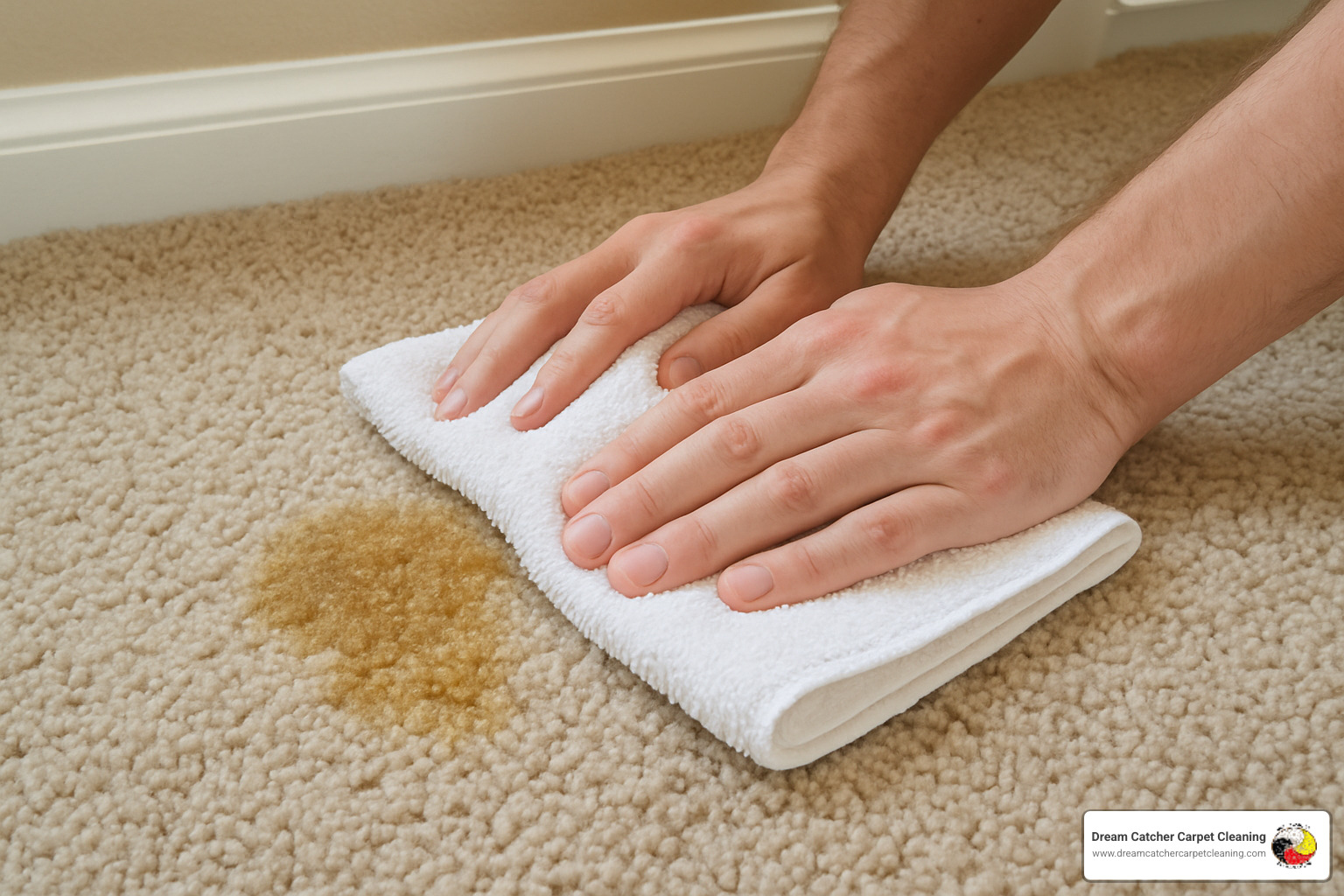
Machine Matters: Using Extractors & Low-Moisture Gear
When you're serious about getting pet stains out of carpet, home extraction equipment can be your secret weapon - if you know how to use it properly. Technique matters more than the price tag on your equipment.
Spot cleaners work beautifully for fresh accidents when you catch them quickly. For bigger jobs or multiple accidents, you'll want a full-size extractor that can handle the heavy lifting.
Here's where most people go wrong: they think more water equals cleaner carpet. Oversaturation is actually your enemy when dealing with pet stains. Too much moisture just pushes contamination deeper into your carpet padding and potentially down to the subfloor.
The smart approach? Multiple light passes instead of one heavy soaking. Think of it like painting a wall - several thin coats always look better than one thick, drippy mess.
Dry passes are absolutely critical for success. Once you've cleaned the area, keep running that extractor in extraction-only mode until you're pulling up almost no moisture. Any dampness left behind becomes a breeding ground for bacteria.
Pre-spray versus inline application makes a huge difference in results. Pre-treating with enzyme cleaners and letting them sit for 30 minutes gives those helpful bacteria time to start breaking down proteins. If you just spray cleaner through the machine as you go, there's no dwell time for the enzymes to work.
One more crucial tip: always use low-foam or defoamer formulations in your machine. Regular carpet shampoos create so many suds they can actually damage your equipment permanently.
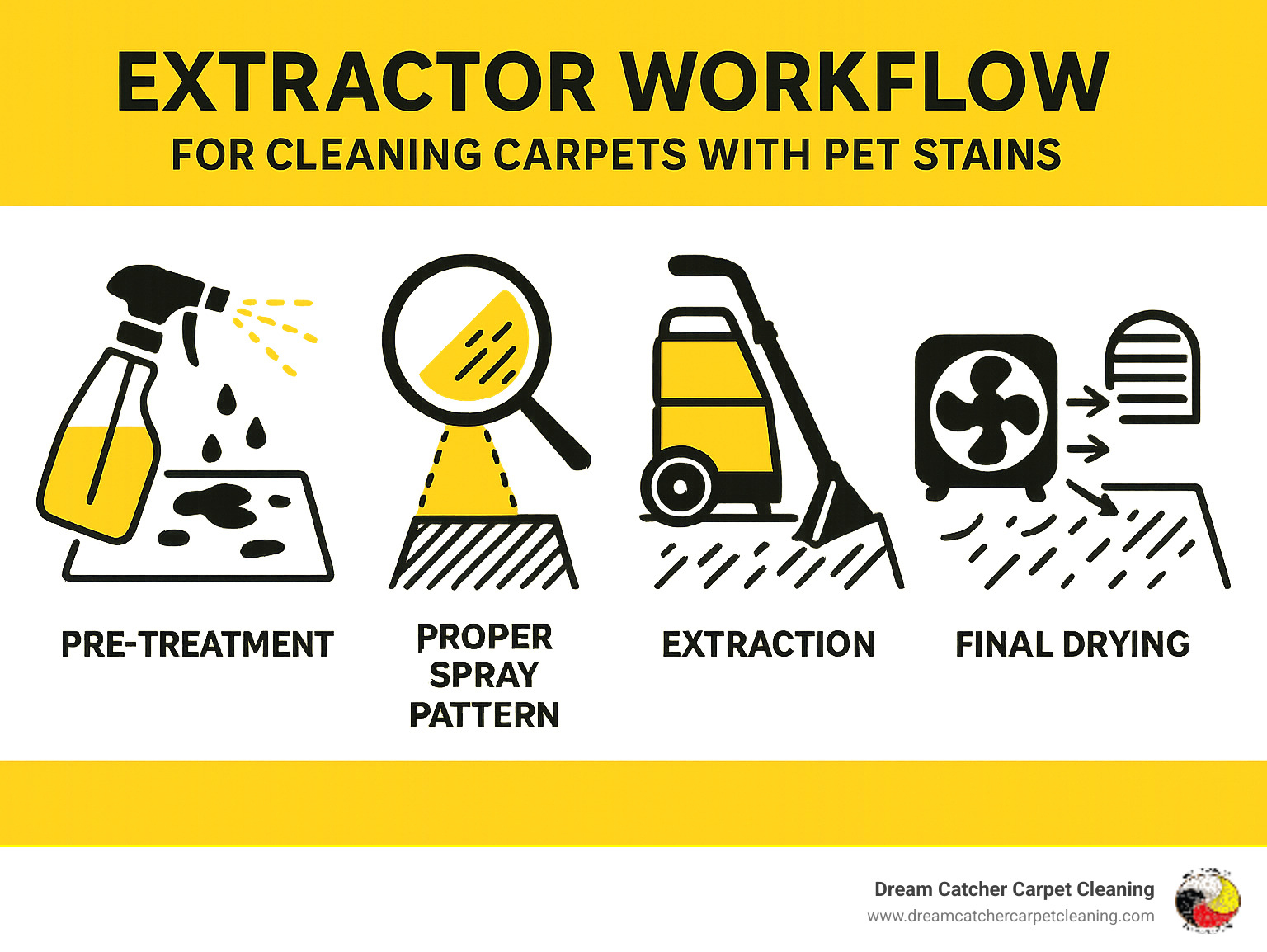
Preparing Carpet Before Running a Machine
The best solution to clean carpets with pet stains starts before you even plug in your machine. Start with a thorough vacuum to remove any loose debris, pet hair, or dirt that could clog your machine's filters.
Loosen up that carpet pile with a soft brush before you start extracting. This opens up the fibers so your cleaning solution can penetrate deeper. Pre-treat those problem areas at least 30 minutes before running your machine. This gives enzyme cleaners time to start breaking down proteins while you're setting up your equipment.
Post-Clean Drying & Grooming
Your cleaning job isn't finished when you turn off the machine. Proper drying and grooming separate okay results from great results.
Fan placement makes all the difference in drying time and final results. Set up fans to create cross-ventilation that moves air across the wet carpet. Open those windows if weather permits. Fresh air circulation prevents that musty smell that can develop when carpets take too long to dry.
Rake those carpet fibers upright as they dry to prevent matting and restore your carpet's original appearance. Prevent wick-back by ensuring rapid, thorough drying. When carpets dry too slowly, dissolved contaminants can actually wick back up to the surface as moisture evaporates.
Odor Prevention & Pet Behavior Hacks
The best solution to clean carpets with pet stains isn't just about cleaning what's already happened - it's about stopping the cycle of repeat accidents. Your pet isn't being spiteful when they keep having accidents in the same spot. They're following their nose to areas that still smell like a bathroom to them.
Enzyme residue actually works in your favor here. When properly applied enzymatic cleaners finish their job, they leave behind beneficial bacteria that continue breaking down any microscopic organic matter. This creates an environment that's less attractive to pets for future marking.
Positive reinforcement training makes a huge difference, but timing is everything. Instead of only scolding accidents, catch your pet using appropriate bathroom areas and reward them immediately.
Litter box hygiene solves most feline carpet issues before they start. Cats are naturally clean animals - they avoid dirty bathrooms just like we do. Daily scooping and weekly complete litter changes prevent that desperate search for alternative bathroom spots.
Don't overlook veterinary health checks when bathroom habits suddenly change. Urinary tract infections, kidney issues, or digestive problems often show up as house training "failures." Your vet can rule out medical causes that no amount of cleaning will fix.
Physical barriers work wonders during retraining periods. Strategic furniture placement or baby gates can restrict access to previously soiled areas while your pet develops new habits.
Here's a critical mistake that actually makes problems worse: never use ammonia-based cleaners on pet accidents. The ammonia smell mimics urine and actually encourages re-marking behavior. Your pet interprets that chemical odor as territorial markings from other animals.
Scientific research on ammonia smell & remarking confirms what we've observed in thousands of homes - pets treat ammonia odors as invitations to establish their own scent markers in those exact spots.
DIY Maintenance Between Deep Cleans
Smart homeowners develop systems for handling minor accidents before they become major headaches. Keep a quick blot kit easily accessible- paper towels, enzyme spray, and disposable gloves stored together where you can grab them fast. Those first 30 seconds after an accident determine how easy cleanup will be.
Baking soda gets recommended everywhere, but use it carefully. While it does absorb odors temporarily, baking soda creates abrasive residues that can actually shorten carpet life when used repeatedly. If you do use it, vacuum thoroughly after 15 minutes.
The club soda myth needs to die. Plain club soda has no special cleaning properties beyond carbonation - you're basically paying premium prices for fizzy water. Save your money and use plain water for initial blotting, then follow up with proper enzymatic treatment.
Entry-mat strategy prevents problems before they start. High-quality mats at doorways reduce tracked-in moisture and debris that can reactivate old pet odors hiding in your carpet.
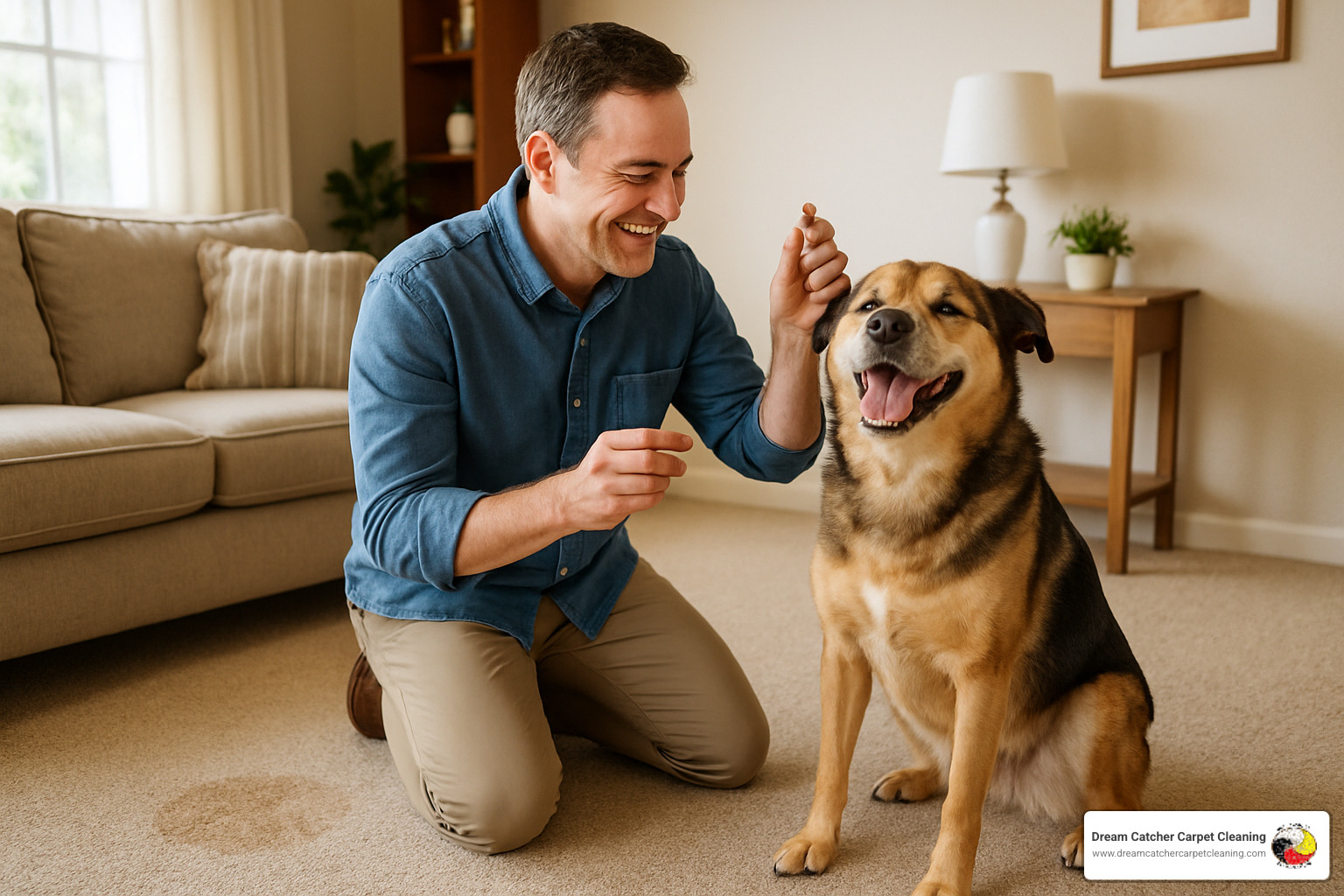
Frequently Asked Questions about the Best Solution to Clean Carpets with Pet Stains
After 22 years of tackling Colorado's messiest pet accidents, I've heard every question imaginable about carpet cleaning. These three come up most often, and the answers might surprise you.
Do enzymes work on year-old stains and lingering odors?
Absolutely, but don't expect overnight miracles. Enzymatic cleaners remain the best solution to clean carpets with pet stains even when they're ancient, but old accidents demand patience and persistence.
Here's what makes year-old stains so stubborn: the urine has crystallized deep in your carpet padding, creating what I call "odor time bombs" that reactivate whenever humidity rises. Those beneficial bacteria in enzyme cleaners can still break down these crystals, but they need serious contact time.
Fresh accidents respond to 30-minute enzyme treatments. Year-old nightmares need 48-72 hours of continuous moisture to fully eliminate odors. Keep treated areas covered with damp towels throughout this period - I know it's inconvenient, but it works.
Most homeowners give up after one treatment, but old stains typically require 2-3 enzyme applications spaced a few days apart. The first treatment handles surface contamination, while subsequent applications tackle the deeper penetration.
There's one important limitation: if previous cleaning attempts used steam cleaners or harsh chemicals, the proteins may have bonded permanently to your carpet fibers. Even the most powerful enzymes can't reverse heat damage - that's why we always ask about previous cleaning attempts before starting treatment.
Can I mix vinegar with an enzymatic cleaner for extra power?
This seems logical, but never mix vinegar directly with enzymatic cleaners- you'll kill the beneficial bacteria that actually eliminate pet waste proteins. It's like using antibacterial soap on yogurt cultures.
However, you can use them as a tag-team approach that's surprisingly effective. Vinegar neutralizes alkaline urine immediately, while enzymes provide long-term protein breakdown. Just use them separately, never together.
Start with a 50/50 white vinegar and water solution to neutralize odors instantly. Blot thoroughly and rinse with plain water - this step is crucial because leftover acid will kill the enzymes. Allow the area to dry completely before applying your enzymatic cleaner as a separate treatment.
This two-step approach combines vinegar's immediate odor knockout with enzymes' deep cleaning power. Many of our customers use this method between professional cleanings with excellent results.
How soon can kids or pets walk on the carpet after cleaning?
Safety timing depends entirely on what products you used and how you applied them. EPA Safer Choice enzymatic cleaners pose minimal risk even when slightly damp, while stronger formulations need complete drying time.
For most enzymatic cleaners, your family can safely return once surface moisture evaporates - typically 2-4 hours with good ventilation. These products are designed to be pet and child safe since they use natural bacterial processes.
Oxygen-based cleaners like hydrogen peroxide require complete drying before foot traffic, usually 4-6 hours depending on your home's humidity and air circulation. The bubbling action continues until all moisture evaporates.
Professional extraction cleaning allows the quickest re-entry because we remove most moisture during the cleaning process. With proper ventilation, families can safely return within 2-3 hours for most treatments.
Special consideration for sensitive individuals: Anyone with allergies or chemical sensitivities should wait a full 24 hours regardless of product type. Better safe than sorry, especially with respiratory concerns.
Always keep windows open and fans running during and after cleaning. Good ventilation not only speeds drying but minimizes any potential respiratory irritation from cleaning residues.
Conclusion
After two decades of tackling Colorado's toughest pet stains, I've learned that the best solution to clean carpets with pet stains isn't just about having the right products - it's about understanding what you're really fighting.
Every pet accident tells a story. Fresh puddles from nervous puppies need immediate attention with oxygen cleaners that work in minutes. But those mysterious odors that appear months later? They're telling you about hidden urine crystals that have been quietly waiting in your carpet padding, and they demand the patience of enzymatic treatments that might take several days to fully work.
The game-changing realizations that separate successful pet stain removal from endless frustration are surprisingly simple. When you grab paper towels for that fresh accident, your speed in those first 30 seconds matters more than having the perfect cleaner. When you're tempted to blast an old stain with your steam cleaner, resist - that heat will turn removable proteins into permanent carpet damage.
Here's what really works: enzymatic cleaners remain your best friend for complete odor elimination, but they need time and moisture to do their job properly. Oxygen-based cleaners excel at quick fixes and surface stains. And sometimes, despite your best efforts with store-bought solutions, professional equipment becomes necessary to reach contamination that's traveled deep into padding or subfloor.
At Dream Catcher Carpet Cleaning, we've seen every possible pet stain scenario across the North Metro Denver area. Our eco-friendly approach means your family and pets can safely enjoy freshly cleaned carpets without worrying about harsh chemical residues. More importantly, our professional-grade extraction equipment can flush out embedded contamination that home machines simply can't reach.
Your maintenance game plan should include immediate response to accidents, quality enzymatic cleaners in your cleaning arsenal, and annual professional deep cleaning to catch problems before they become permanent. Think of it as preventive medicine for your carpets.
The best solution to clean carpets with pet stains combines smart product choices with proper technique - and the wisdom to recognize when professional help will save you time, money, and frustration in the long run.

